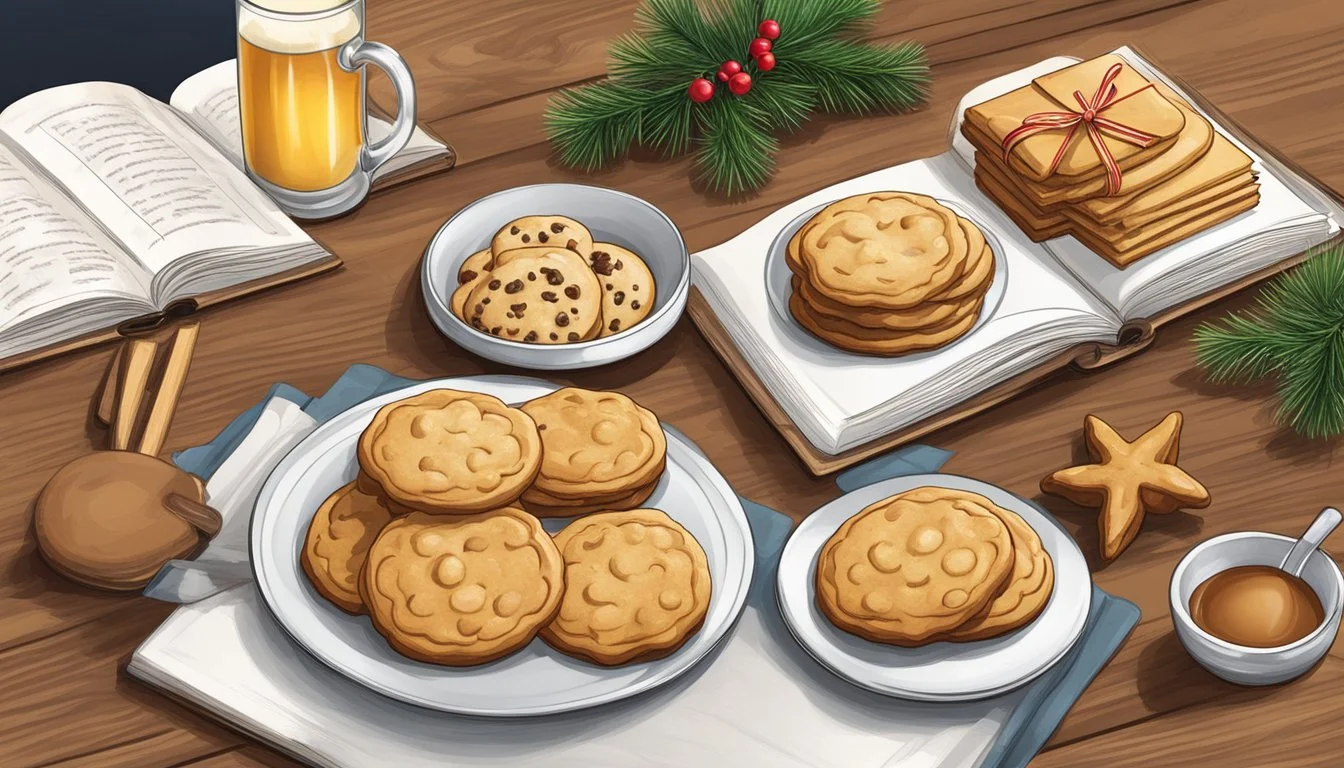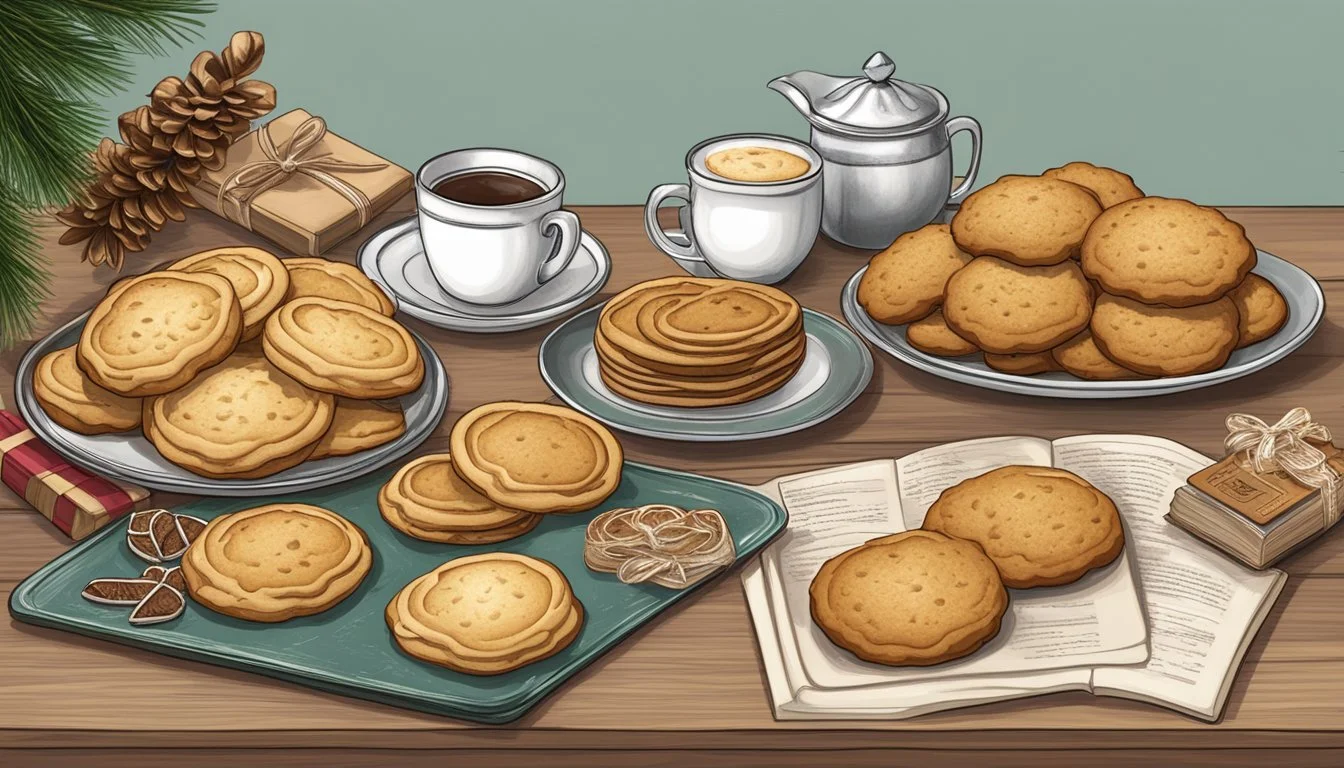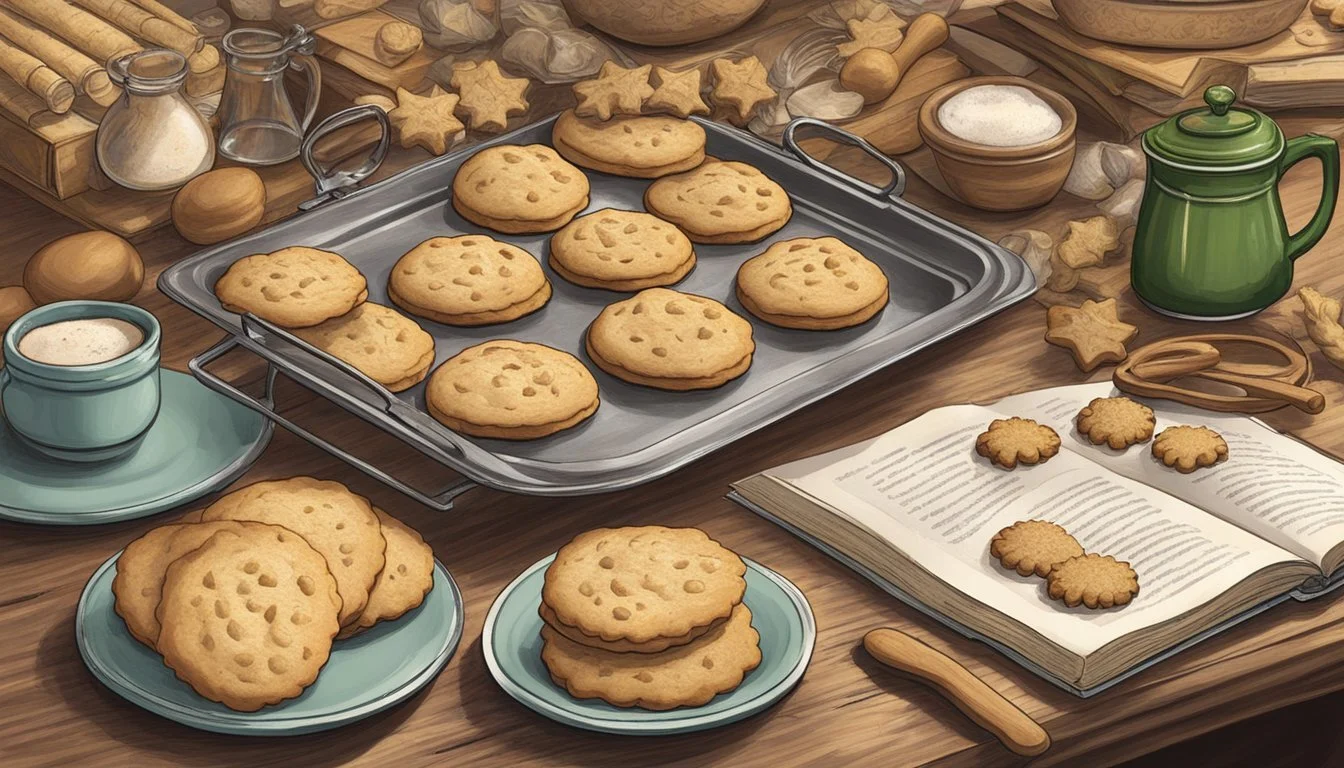German Texan Christmas Cookie Traditions
A Guide to Celebrating with Authentic Recipes
The fusion of German and Texan cultures during the 19th century gave rise to a unique culinary tradition, especially noticeable during the Christmas season. German immigrants brought with them their festive customs and cookie recipes, which they adapted using local Texan ingredients. This blend of heritages is evident in the Christmas cookies that are a staple in German Texan households, combining the flavors and spices of Central Europe with the distinct character of the Lone Star State.
In Texas, these cookies are more than just holiday treats; they are a link to ancestral heritage and a testament to the state's cultural mosaic. Traditional German cookies such as Vanillekipferl, buttery vanilla crescents dusted with confectioner's sugar, and Pfeffernüsse, small spice cookies coated in powdered sugar, are holiday favorites. Meanwhile, adaptations might include local pecans in Nussecken, a delightful triangular cookie with a layer of jam and nuts, or a hint of bourbon in place of traditional rum.
Family recipes are often passed down from generation to generation, each adding their own touch while keeping the spirit of the original recipes alive. These cookies are not only enjoyed within families but also shared widely among communities, reflecting the hospitality and warmth for which both Germans and Texans are known. As Christmas approaches, kitchens across the state are filled with the aromatic blend of spices like cinnamon, cloves, and nutmeg, signifying the beginning of the holiday baking season and the continuation of German Texan Christmas traditions.
Historical Context of German Texan Christmas Cookies
The traditions surrounding German Texan Christmas cookies stem from a rich tapestry of German heritage, intertwining with Texan culture over time. This fusion is particularly embodied in the Christmas season, where baking and sharing cookies is a heartfelt tradition.
Influence of German Heritage on Texan Christmas
German immigrants brought their festive customs and culinary practices to Texas as early as the 1830s. They carried with them traditional German Christmas cookies, known as Weihnachtsplätzchen, which have since become an integral part of Texan holiday celebrations. During the Christmas season, these pastries blend the flavors and festive spirit of Germany with the communal customs of the Texan holiday scene.
The Germans in Texas were known for their communal celebrations, which often featured caroling and, crucially, the sharing of homemade cookies representative of their homeland's recipes. Recipes typically included:
Stollen: A fruit bread laden with nuts, spices, and dried or candied fruit, coated with powdered sugar or icing sugar.
Lebkuchen: Spiced cookies somewhat resembling gingerbread, often glazed with sugar or chocolate.
Vanillekipferl: Small, crescent-shaped biscuits made with ground nuts and dusted with vanilla sugar.
Zimtsterne: Cinnamon stars made from ground nuts, cinnamon, and egg whites.
The ritual of baking these cookies was often a family affair, with recipes passed down through generations. Each recipe encapsulated a piece of German tradition, adapted to the Texan palate and ingredients available. Germans in Texas would gather to bake in preparation for the Advent season, with each family often having their unique twist on the classic recipes.
Ingredients in Traditional German Texan Cookies
Traditional German Texan cookies blend the culinary heritage of Germany with the local flavors of Texas. As such, the ingredients are a hearty mix of rich spices, varied nuts, and foundational baking essentials.
Spices and Flavorings
German Texan cookies are known for their bold and aromatic spices. Some key flavorings include:
Cinnamon: Gives a warm, spicy flavor, often used in Cinnamon Stars.
Vanilla: A classic flavor, particularly in delicate Vanillekipferl (vanilla crescents).
Ginger: Offers a fiery zing, commonly found in gingerbread variants.
Nutmeg: Adds depth and sweetness, used in small quantities.
Cloves: A strong and pungent spice that energizes taste buds.
Pepper: Often white pepper, which introduces a subtle, sharp heat.
Lemon Peels: Provide a citrus zing for a fresh, light note.
Nuts and Seeds
German Texan cookies frequently incorporate nuts and seeds for texture and taste:
Almonds: Both whole and in the form of almond flour, almonds are a foundation for cookies like Cinnamon Stars.
Hazelnuts: Another favorite nut that adds rich, nutty flavors to the cookies.
Flours and Sugars
The base of these cookies often starts with foundational elements:
Flour: The primary building block for cookie structure, ranging from all-purpose to nut based flours like almond flour.
Sugar: From white granulated to powdered, sugar adds the essential sweetness.
Butter: Provides moisture and a tender crumb to the cookies.
Eggs: Serve as a binding agent and enrich the dough for a better texture.
These ingredients combine resulting in cookies that are not only festive but also brimming with the taste of tradition and a touch of Texan charm.
Iconic German Texan Christmas Cookies
German Texan cookie traditions blend the rich flavors of Germany's beloved weihnachtsplätzchen with Texan influences, showcasing a variety of spices, nuts, and unique shapes that are integral to the festive season.
Lebkuchen and its Varieties
Lebkuchen, also known as gingerbread, is a cornerstone of German Texan Christmas celebrations. This moist and flavorful cookie often contains honey, spices like ginger and nutmeg, and sometimes candied fruit. Elisenlebkuchen, a premium variant, is particularly dense with nuts and topped with either a simple icing or a thin layer of oblaten, a wafer-like bottom.
Vanillekipferl and Springerle
Vanillekipferl, recognizable by their crescent shape, are made with ground almonds or hazelnuts, butter, and dusted with vanilla sugar, giving them their signature aroma. Springerle are anise-flavored cookies known for their intricate designs, pressed using a mould before baking. They have a unique, hard texture that softens over time.
Pfeffernüsse and Zimtsterne
Pfeffernüsse are small, round cookies coated in either powdered sugar or a glaze, seasoned with a mix of aromatic spices like cinnamon, cloves, and sometimes, anise. A key characteristic is their slightly spicy kick. Zimtsterne, or cinnamon stars, are made from almond meal, egg whites, and cinnamon, creating a chewy texture and are traditionally topped with a meringue frosting.
The Tradition of Stollen and Makronen
Stollen is a rich, dense bread filled with dried fruits, nuts, spices, and often marzipan, then dusted with powdered sugar. Though not a cookie, its significance in German Texan Christmas is undeniable. Makronen encompasses a variety of cookies like coconut macaroons (Kokosmakronen) and hazelnut macaroons (Haselnussmakronen), which are celebrated for their simplicity and delightful chewiness, thanks to the use of egg whites and sugar.
Each of these German Texan cookies carries a piece of history and tradition, offering a sweet taste of heritage during the holiday season.
Traditional Recipes and Methods
In this section, readers will gain insight into authentic recipes that encapsulate the spirit of a German Texan Christmas, and learn important baking techniques to recreate these traditional cookies. Detailed recipes feature ingredients like nuts, spices, and marzipan, while techniques focus on methods such as dough preparation and proper baking.
Guide to Authentic Recipes
Traditional German Christmas cookies, or Weihnachtsplätzchen, are staples in German Texan households. One can find a variety of recipes, each with its own blend of ingredients like butter, eggs, flour, and vanilla sugar. Key to these treats are spices such as anise and gingerbread seasonings, which provide the distinctive holiday flavors. A few must-try recipes include:
Lebkuchen: A gingerbread-like cookie that often includes nuts, honey, and a variety of spices.
Bethmaennchen: These marzipan-based cookies are adorned with almonds and sometimes represent a family tradition by including family recipes passed down through generations.
For a gluten-sensitive palate, alternatives using gluten-free flour blends are available, ensuring everyone can partake in the festivities.
Cookies like Pfeffernüsse and Nussecken integrate a mix of sweet and spicy notes, with the latter featuring a decadent addition of rum. Bakers often finish these cookies with a touch of confectioners' sugar or a chocolate glaze.
Baking Techniques and Tips
Producing the quintessential German Texan Christmas cookies requires precision and adherence to tried-and-true methods:
Utilizing a food processor can ensure that nuts are finely ground and that dough achieves a consistent texture.
When making cookies such as Vanillekipferl, which are delicate and crescent-shaped, it is crucial to measure ingredients correctly and to handle the dough gently.
Baking cookies on parchment paper atop a baking sheet helps with even heat distribution and prevents sticking, without the need for additional greasing.
To achieve the proper flavor profile for cookies like Lebkuchen, it's essential to let the dough rest, allowing the spices to fully infuse their flavor.
An accurate oven temperature is key, as well as timing; traditional cookies often have a specific texture, ranging from soft and chewy to crisp and crumbly.
Through following these recipes and methods, one can create a batch of German Texan Christmas cookies that are as authentic as they are delightful.
Modern Adaptations and Dietary Variations
Reflecting an awareness of varying dietary requirements and preferences, today's kitchens see a range of adaptations to traditional German Texan Christmas cookie recipes. These modifications allow individuals with specific dietary restrictions or choices to still enjoy festive treats.
Vegan and Gluten-Free Alternatives
Vegan variations often substitute dairy components like butter with plant-based alternatives such as coconut oil or vegan butter. Similarly, eggs can be replaced with flax or chia seeds mixed with water to achieve a binding effect. Gluten-free needs are met by employing flour substitutes, with almond flour being a favored choice for its nutty flavor and richness, aligning well with the traditional profile of German Christmas cookies that often contain nuts.
Dairy Substitutes:
Butter → Coconut Oil / Vegan Butter
Milk → Almond Milk / Soy Milk
Egg Substitutes:
1 Egg → 1 Tablespoon Ground Flaxseed + 3 Tablespoons Water
For those avoiding gluten, family recipes like Zimtsterne (cinnamon stars) can be easily adapted using gluten-free baking mix or nut-based flours to maintain their classic taste.
Contemporary Twists on Classic Flavors
Experimentation with flavor has led to the incorporation of non-traditional spices such as cardamom and allspice alongside classics like nutmeg and cinnamon, offering a contemporary edge to the familiar warm spices of the holiday season. Vanilla, a staple in German cookie recipes, is sometimes enhanced with vanilla bean paste instead of extract, providing a more intense flavor. The adaptability of these cookies encourages bakers to personalize recipes, merging timeless traditions with current tastes and dietary considerations.
Notable Flavor Adaptations:
Cinnamon → Include Cardamom
Vanilla Extract → Use Vanilla Bean Paste
Cultural Significance and Celebratory Practices
In Texas's German communities, Christmas traditions synergize Texan warmth with the rich customs of German ancestry, emphasizing the importance of communal festivities and culinary legacies.
Christmas in German Texan Society
The onset of the first of Advent marks a significant period for German Texans as it allows the blend of Texan hospitality with German festive traditions. This cultural merger is prominently visible in the practices that build up to Christmas. Caroling and Advent celebrations take on a German flavor, particularly in the singing of traditional German carols that have been preserved and passed down through generations.
German Texan societies, often originating in the 19th century, have kept alive the German customs of Christmas, which are especially vibrant in towns like New Braunfels. Here, events like Wurstfest, although not a Christmas event itself, reflect the joyous festive spirit that carries over into the Christmas season, with echoes of Germany's long-standing traditions.
Family Traditions and Community Gatherings
The community comes together to mark the season not just in song and festival but also in the kitchen. Weihnachtsplätzchen, or Christmas cookies, become a definitive element of the season's gastronomy. Families pride themselves on their treasured recipes, often passed down for generations, turning cookie baking into a familial rite that strengthens bonds and cultural identity.
Traditionally, the baking starts on the first Sunday of Advent and continues through to Christmas. The following is an illustrative list of some cherished Weihnachtsplätzchen:
Stollen: A fruit bread laden with spices and marzipan
Lebkuchen: German gingerbread soft in texture
Zimtsterne: Cinnamon stars usually topped with icing
Vanillekipferl: Crescent-shaped vanilla cookies
Spritzgebäck: Crisp, buttery pressed cookies
In community gatherings, these cookies are shared and celebrated, reinforcing a sense of community and identity through shared tastes and traditions that have become a treasured part of the German Texan Christmas experience.
Baking Tools and Presentation
The right tools and presentation methods are essential for creating and sharing German Texan Christmas cookies that are as delightful to look at as they are to eat. Attention to detail in the baking process and thoughtful presentation preserve tradition and enhance the festive spirit.
Essentials for German Cookie Baking
For authentic German cookie-baking, one must be equipped with several key tools:
Cookie Cutters: A variety of shapes, including classic Christmas motifs such as stars, angels, and bells, are used to create the desired aesthetic for cookies like buttery Spritzgebäck.
Parchment Paper: This non-stick baking essential ensures cookies can be removed easily from baking sheets, maintaining their intricate designs.
Baking Sheet: A flat, heat-resistant tray is indispensable for achieving the perfect bake. German cookies are often delicate, and a quality baking sheet helps to distribute heat evenly.
Serving and Packaging Christmas Cookies
The presentation of German Texan Christmas cookies is an opportunity to showcase the baker's craftsmanship:
Plating: Arranged on a festive platter, cookies like Bethmaennchen can be adorned with red currant jam, adding a jewel-like finish to each piece.
Packaging: When gifting, transparent cellophane or decorative tins keep cookies fresh and allow the details of cookies like spiced Pfeffernüsse to be appreciated at first glance.
These guidelines help one honor the rich heritage of German Texan Christmas cookie-making while ensuring each batch looks as good as it tastes.
Conclusion
The festive season in German-Texan households showcases a delightful fusion of cultures through the medium of baked goods. Traditional German Christmas cookies are a key part of the holiday festivities. Vanillekipferl, crescent-shaped vanilla cookies, and Lebkuchen, spiced gingerbread-like cookies, are favorites that have woven their way into the fabric of Texan holiday traditions.
Table: Popular German-Texan Christmas Cookies
German Cookie Description Vanillekipferl Crescent-shaped, vanilla-flavored dusted with confectioners' sugar Lebkuchen Soft, gingerbread-like, often glazed or chocolate-covered Zimtsterne Cinnamon stars typically made with almonds or hazelnuts Butter Cookies Simple yet rich, perfect for decoration and often a family recipe staple
These cookies are not only a treat to the palate but carry with them generations of heritage. In baking sessions, families often use recipes passed down through the years, creating a tangible link to their ancestry.
They also offer a warm, welcoming aroma that fills homes during the holiday season, contributing to the Christmas ambience. While certain ingredients like butter, eggs, and flour are common denominators, each cookie variety has its unique set of spices and nuts which lend them distinctive flavors.
The German-Texan community thus preserves its heritage while embracing their present home's culture through these time-honored traditional recipes. Baking these cookies is more than just preparation for a holiday; it is a festive rite, enveloping all senses and celebrating the spirit of togetherness and shared history.









